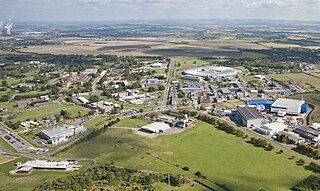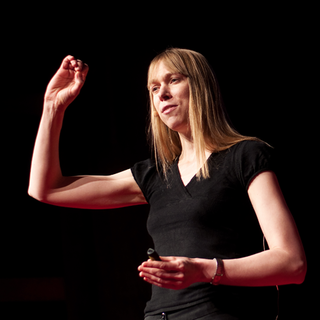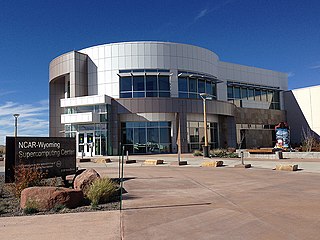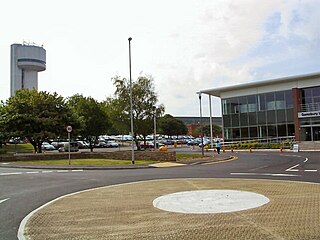Related Research Articles

Blue Gene was an IBM project aimed at designing supercomputers that can reach operating speeds in the petaFLOPS (PFLOPS) range, with low power consumption.

The Rutherford Appleton Laboratory (RAL) is one of the national scientific research laboratories in the UK operated by the Science and Technology Facilities Council (STFC). It began as the Rutherford High Energy Laboratory, merged with the Atlas Computer Laboratory in 1975 to create the Rutherford Lab; then in 1979 with the Appleton Laboratory to form the current laboratory.

The ISIS Neutron and Muon Source is a pulsed neutron and muon source, established 1984 at the Rutherford Appleton Laboratory of the Science and Technology Facilities Council, on the Harwell Science and Innovation Campus in Oxfordshire, United Kingdom. It uses the techniques of muon spectroscopy and neutron scattering to probe the structure and dynamics of condensed matter on a microscopic scale ranging from the subatomic to the macromolecular.

EPCC, formerly the Edinburgh Parallel Computing Centre, is a supercomputing centre based at the University of Edinburgh. Since its foundation in 1990, its stated mission has been to accelerate the effective exploitation of novel computing throughout industry, academia and commerce.
HECToR was a British academic national supercomputer service funded by EPSRC, Natural Environment Research Council (NERC) and BBSRC for the UK academic community. The HECToR service was run by partners including EPCC, Science and Technology Facilities Council (STFC) and Numerical Algorithms Group (NAG).

Daresbury Laboratory is a scientific research laboratory based at Sci-Tech Daresbury campus near Daresbury in Halton, Cheshire, England. The laboratory began operations in 1962 and was officially opened on 16 June 1967 as the Daresbury Nuclear Physics Laboratory (DNPL) by the then Prime Minister of United Kingdom, Harold Wilson. It was the second national laboratory established by the British National Institute for Research in Nuclear Science, following the Rutherford High Energy Laboratory. It is operated by the Science and Technology Facilities Council, part of UK Research and Innovation. As of 2018, it employs around 300 staff, with Paul Vernon appointed as director in November 2020, taking over from Professor Susan Smith who had been director from 2012.
The Science and Technology Facilities Council (STFC) is a United Kingdom government agency that carries out research in science and engineering, and funds UK research in areas including particle physics, nuclear physics, space science and astronomy.
The QCDOC is a supercomputer technology focusing on using relatively cheap low power processing elements to produce a massively parallel machine. The machine is custom-made to solve small but extremely demanding problems in the fields of quantum physics.
Exascale computing refers to computing systems capable of calculating at least "1018 IEEE 754 Double Precision (64-bit) operations (multiplications and/or additions) per second (exaFLOPS)"; it is a measure of supercomputer performance.
Christine Tullis Hunter Davies is a professor of physics at the University of Glasgow.
The ICG is a research institute at the University of Portsmouth devoted to topics in cosmology, galaxy evolution and gravitation. It has nearly 50 staff, post-docs and students working on subjects from inflation in the early Universe to understanding the stellar populations in galaxies.

Several centers for supercomputing exist across Europe, and distributed access to them is coordinated by European initiatives to facilitate high-performance computing. One such initiative, the HPC Europa project, fits within the Distributed European Infrastructure for Supercomputing Applications (DEISA), which was formed in 2002 as a consortium of eleven supercomputing centers from seven European countries. Operating within the CORDIS framework, HPC Europa aims to provide access to supercomputers across Europe.
GridPP is a collaboration of particle physicists and computer scientists from the United Kingdom and CERN. They manage and maintain a distributed computing grid across the UK with the primary aim of providing resources to particle physicists working on the Large Hadron Collider (LHC) experiments at CERN. They are funded by the UK's Science and Technology Facilities Council. The collaboration oversees a major computing facility called the Tier1 at the Rutherford Appleton Laboratory (RAL) along with the four Tier 2 organisations of ScotGrid, NorthGrid, SouthGrid and LondonGrid. The Tier 2s are geographically distributed and are composed of computing clusters at multiple institutes.

The high performance supercomputing program started in mid-to-late 1980s in Pakistan. Supercomputing is a recent area of Computer science in which Pakistan has made progress, driven in part by the growth of the information technology age in the country. Developing on the ingenious supercomputer program started in 1980s when the deployment of the Cray supercomputers was initially denied.

Catherine Heymans is a British astrophysicist, the Astronomer Royal for Scotland, and a professor at the University of Edinburgh based at the Royal Observatory, Edinburgh.

Quantum Detectors Limited is a spin-out company from the Diamond Light Source and Science and Technology Facilities Council, although it also commercialises technology from other large scale facilities such as the European Synchrotron Radiation Facility. The function of the company is to take to market developments that would otherwise only be used by the funders of the development; this wider use of these new technologies benefits the scientific community through improved facilities and the developer through aiding them in meeting their impact / knowledge transfer obligations.

The NCAR-Wyoming Supercomputing Center (NWSC) is a high-performance computing (HPC) and data archival facility located in Cheyenne, Wyoming, that provides advanced computing services to researchers in the Earth system sciences.

The Institute for Computational Cosmology (ICC) is a research institute at Durham University, England. It was founded in November 2002 as part of the Ogden Centre for Fundamental Physics, which also includes the Institute for Particle Physics Phenomenology (IPPP). The ICC's primary mission is to advance fundamental knowledge in cosmology. Topics of active research include: the nature of dark matter and dark energy, the evolution of cosmic structure, the formation of galaxies, and the determination of fundamental parameters.

The Hartree Centre is a high performance computing, data analytics and artificial intelligence (AI) research facility focused on industry-led challenges. It was formed in 2012 at Daresbury Laboratory on the Sci-Tech Daresbury science and innovation campus in Cheshire, UK. The Hartree Centre is part of the Science and Technology Facilities Council (STFC) which itself is part of United Kingdom Research and Innovation (UKRI).
References
- ↑ "Mark Wilkinson". DiRAC. Retrieved 13 October 2023.
- 1 2 "DiRAC - Science and Technology Facilities Council". stfc.ac.uk.
- 1 2 "What makes DiRAC special". dirac.ac.uk.[ permanent dead link ]
- ↑ "Edinburgh DiRAC Resource Grant". UK Research and Innovation. Retrieved 18 September 2024.
- ↑ "DiRAC-3 Launch Day". DiRAC. Retrieved 22 August 2023.
- ↑ "Resources". DiRAC. Retrieved 22 August 2023.
- ↑ Dalitz, Richard H.; Peierls, Rudolf (1986). "Paul Adrien Maurice Dirac. 8 August 1902 – 20 October 1984". Biographical Memoirs of Fellows of the Royal Society . 32. London: Royal Society: 139–185. doi: 10.1098/rsbm.1986.0006 . JSTOR 770111.